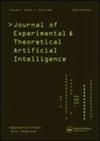COVID - pro - net:利用迁移学习和q -变形熵从肺部x线和CT图像中检测COVID - 19患者的预后工具
IF 1.7
4区 计算机科学
Q3 COMPUTER SCIENCE, ARTIFICIAL INTELLIGENCE
Journal of Experimental & Theoretical Artificial Intelligence
Pub Date : 2021-07-15
DOI:10.1080/0952813X.2021.1949755
引用次数: 3
摘要
人类面临多次大流行疫情,由严重急性呼吸系统综合征冠状病毒2引起的冠状病毒病(COVID-19)被世界卫生组织(WHO)列为紧急疫情。认识COVID-19是一项具有挑战性的任务。最常用的检查方法是x线和CT扫描图像。它需要专门的医疗专业人员手动报告每位患者的健康状况。研究发现,新冠肺炎与肺炎肺部疾病有相当大的相似性。因此,从肺炎诊断模型中学到的知识可以转化为识别COVID-19。与传统的分类方法相比,迁移学习方法具有显著的性能。在本研究中,图像预处理是为了减轻医学图像之间的强度差异。这些处理后的图像进行特征提取,使用q变形熵和深度学习提取来完成。特征提取技术用于去除图像中的异常标记,去除组织和病变中的噪声阻抗。将获得的特征综合起来,以区分COVID-19、肺炎和健康病例。该模型的主要目的是为医疗专业人员提供图像处理工具。该模型的结果是检查健康或COVID-19个体如何优于传统模型。所采集数据集的最大准确率为99.68%。本文章由计算机程序翻译,如有差异,请以英文原文为准。
COVIDPRO-NET: a prognostic tool to detect COVID 19 patients from lung X-ray and CT images using transfer learning and Q-deformed entropy
ABSTRACT The humankind had faced several pandemic outbreaks, and coronavirus illness (COVID-19) caused by severe, acute respiratory syndrome coronavirus 2, is designated an emergency by the World Health Organization (WHO). Recognition of COVID-19 is a challenging task. The most commonly used methods are X-ray and CT scans images to inspect COVID-19 patients. It requires specialised medical professionals to report each patient’s health manually. It is found that COVID-19 shows considerable similarity to pneumonia lung disease. Thus, knowledge learned from a model to diagnose pneumonia can be translated to identify COVID-19. Transfer learning method offers a drastic performance when compared with results from conventional classification. In this study, Image pre-processing is done to alleviate intensity variations between medical images. These processed images undergo a feature extraction which is accomplished using Q-deformed entropy and deep learning extraction. The feature extraction techniques are employed to remove abnormal markers from images, noise impedance from tissues and lesions. The traits acquired are integrated to differentiate between COVID-19, pneumonia and healthy cases. The primary aim of this model is to produce an image processing tool for medical professionals. The model results to inspect how a healthy or COVID-19 individual outperforms conventional models. The maximum accuracy of the collected data set is 99.68%.
求助全文
通过发布文献求助,成功后即可免费获取论文全文。
去求助
来源期刊
CiteScore
6.10
自引率
4.50%
发文量
89
审稿时长
>12 weeks
期刊介绍:
Journal of Experimental & Theoretical Artificial Intelligence (JETAI) is a world leading journal dedicated to publishing high quality, rigorously reviewed, original papers in artificial intelligence (AI) research.
The journal features work in all subfields of AI research and accepts both theoretical and applied research. Topics covered include, but are not limited to, the following:
• cognitive science
• games
• learning
• knowledge representation
• memory and neural system modelling
• perception
• problem-solving

 求助内容:
求助内容: 应助结果提醒方式:
应助结果提醒方式:


